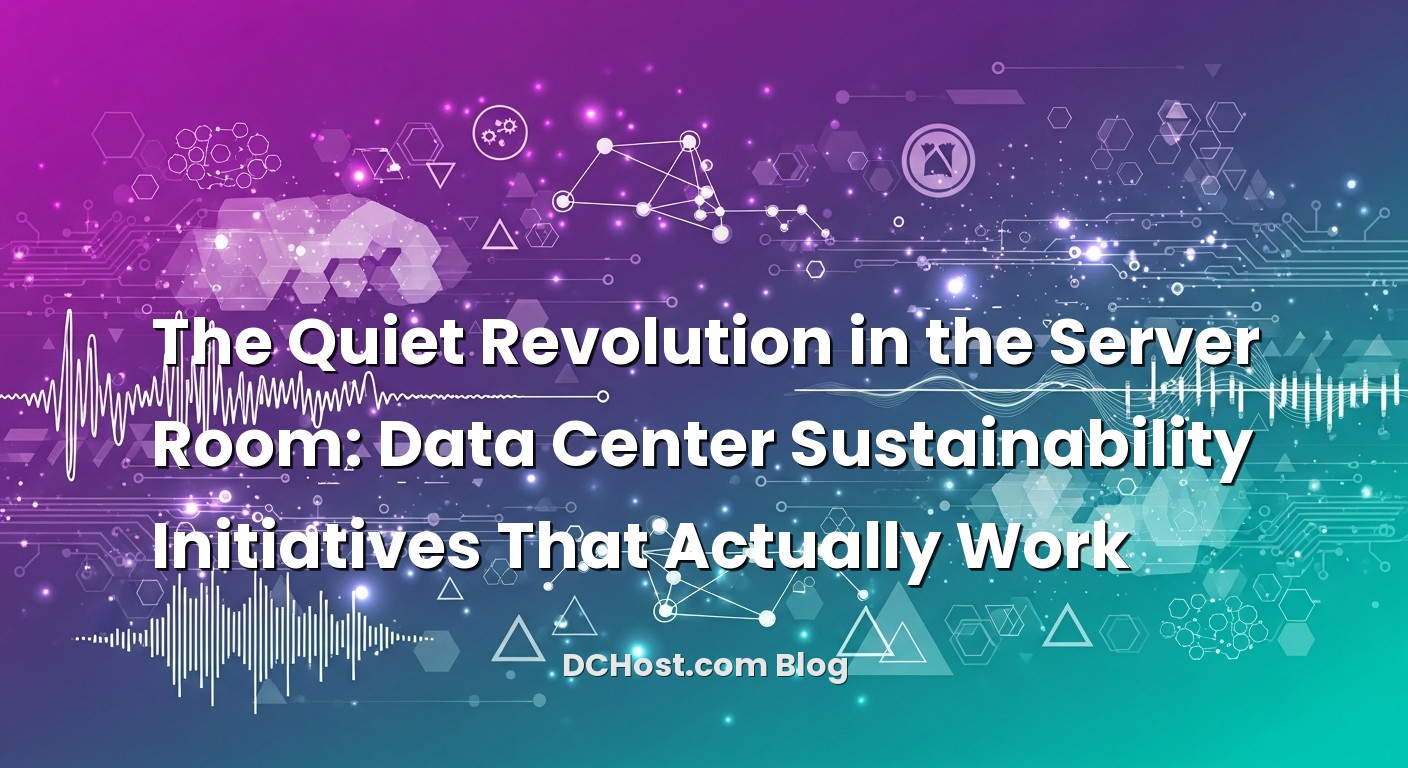So there I was again, standing in a data hall that sounded like a white‑noise machine wrapped in a jet engine, staring at rows of blue LEDs blinking like city lights at night. I’d been invited to look at a cluster that wouldn’t stop running hot, and it hit me—this building is the nervous system of dozens of online businesses. Every cart checkout, every late‑night blog read, every API call—somewhere, a server is breathing a little heavier. And each breath has a footprint. Ever had that moment when you realize the web isn’t intangible at all? It’s humming fans, pumps, batteries, and a power bill that can make CFOs wince.
That day, the fix wasn’t a fancy upgrade or a shiny new feature. It was a few smart sustainability tweaks—some airflow containment, better scheduling, and killing off a couple of zombie instances—that cooled the room and cooled the invoices. That’s the thing about data center sustainability initiatives: done right, they’re not just good for the planet; they’re practical, cost‑cutting, and oddly satisfying. In this post, I want to walk you through what’s working in real life. We’ll talk cooling that doesn’t fight physics, power that isn’t wasted, software choices that sip instead of chug, and the human habits that make it stick. No guilt trips, no buzzword salad—just the tactics I’ve seen quietly change rooms that never sleep.
İçindekiler
- 1 The Invisible Machine Behind Your Site—and Why Sustainability Matters
- 2 Measuring What Matters Without Losing the Plot
- 3 Cooling That Works With Physics, Not Against It
- 4 Power, Hardware Choices, and the Myth of “Just Add More”
- 5 Software Sips Power Too: Caching, Scheduling, and Code That Doesn’t Waste Watts
- 6 Water, Waste, and the Lifecycle We Don’t See
- 7 Cleaner Power, Smarter Grids, and the Art of Timing
- 8 The Culture That Makes It Stick: Small Habits, Big Results
- 9 Real‑World Tactics I Keep Reaching For
- 10 Wrap‑Up: The Web’s Beating Heart Can Be Gentle
The Invisible Machine Behind Your Site—and Why Sustainability Matters
It’s easy to forget that your website, app, or store is a physical thing somewhere. Sure, it lives “in the cloud,” but the cloud is just someone else’s servers—real metal, real heat, real power. The first time I toured a facility years ago, I remember the shock of how simple the math looks: convert electricity into compute, turn compute into heat, then spend more electricity getting the heat out. When you see it like that, sustainability stops being a nice‑to‑have and becomes a design challenge: how do we do the same work with less energy, less water, and less waste?
Here’s where it gets exciting. Sustainability isn’t one big lever—it’s a dozen small ones: right‑sizing workloads, improving airflow, shifting jobs to cleaner hours, tuning code paths, reusing heat, rethinking hardware lifecycles, and yes, buying cleaner power. In my experience, the magic comes from layering these moves. One change helps, two changes are noticeable, and five changes feel like flipping the room into a different era. The trick is to make them practical so your team actually sticks with them.
Measuring What Matters Without Losing the Plot
Before we get into shiny solutions, you have to measure the right things. Think of metrics like the gauges on a car dashboard—you don’t fix the engine by staring at the speedometer, but you’d be reckless not to have it. In data centers, you’ll hear lots of talk about efficiency ratios. The famous one is PUE, which looks at how much extra power you spend on things like cooling and distribution, beyond the power used by the IT gear itself. If you want a friendly primer, I like the Green Grid’s explanation of PUE. Just don’t treat it like a video game high score—PUE is helpful, but it’s not the whole story.
What keeps me grounded is a simple question: are we doing the same work with less energy and less waste? That means looking past a single metric and paying attention to heat maps, airflow patterns, power distribution, water usage, and the power profile over time. If your power draw spikes at the same hours every day, can you shift some work? If you keep the CRAHs chilly because a few hotspots misbehave, could you solve the airflow instead and let the room warm slightly without sweating the racks?
I like to think of sustainability as a triad: power, cooling, and utilization. You can have efficient cooling and clean power, but if you’re running 30% utilized servers 24/7, that’s wasted potential. Flip it around: squeeze better utilization from the same hardware, and suddenly the cooling and power curves flatten in all the right places.
Cooling That Works With Physics, Not Against It
Cooling is where I’ve seen the fastest wins, probably because heat is honest. Warm air rises. Cold air moves where it’s pulled. Equipment doesn’t care about ego or spreadsheets; it just follows thermodynamics. The simplest, most impactful changes almost always start with airflow.
Hot aisle/cold aisle containment sounds fancy, but it’s basically making sure the air your servers inhale is cool and the air they exhale doesn’t drift right back into the intake. In the early days, I remember a site where we were “chasing cold” all week long—turning the thermostat lower and lower until the room was freezing while the top‑of‑rack temps still spiked. We added blanking panels, sealed cable cutouts, and contained the hot aisle. Like flipping a switch, the exhaust air stopped mixing and the whole place calmed down. We actually nudged the setpoint up a couple of degrees after that, and no one noticed except the power bill.
Free cooling is another favorite. When the outside air is cool enough, let it do the heavy lifting. You’d be amazed how often climates allow economizers to shoulder a big chunk of the year’s cooling load. And then there’s liquid cooling, which used to be rare but now feels inevitable with higher rack densities. Direct‑to‑chip loops keep the hottest components from roasting the room, and the water temperatures don’t need to be anything like “chilled” to be effective. I remember the first time I put my hand behind a liquid‑cooled server and felt… not much. It was weirdly anticlimactic and absolutely beautiful.
There’s also the overlooked art of fan speed tuning and smarter control loops. Spiky fan profiles waste power just to chase noisy signals. Smoother targets, steadier airflow, and a little patience from your PID loops can reduce overshoot. Pair that with reasonable temperature bands—aligned with modern hardware tolerances—and you can avoid the old habit of making rooms Arctic just to feel safe. If you want to go deep on environment ranges, ASHRAE has entire playbooks for it, but the friendly version is this: find the highest safe setpoint that keeps your equipment and your staff genuinely comfortable, and then keep the air where it belongs.
Power, Hardware Choices, and the Myth of “Just Add More”
Here’s the thing about power: it’s not just what you buy—it’s how you use it. I’ve walked into facilities where the UPS and distribution are beautifully maintained, yet the IT floor is full of servers half‑doing things no one needs anymore. We turn off two racks’ worth of “just in case” instances and the whole building sighs in relief. Zombie compute is real, and it’s hungry.
Hardware efficiency starts with the basics: modern power supplies, high‑efficiency VRMs, and components that deliver performance per watt instead of raw peak numbers you’ll never touch. Storage matters here more than people think. Fast NVMe can finish tasks quickly and idle more often—especially if you’re not bottlenecked by I/O wait. Compute architecture plays a role too; sometimes a lower‑clocked, core‑rich layout beats a couple of hot‑headed beasts that run loud and idle worse.
But let me tell you about the biggest lever: right‑sizing. Overprovisioning used to be the default because peaks were scary, and nobody wanted to be the reason checkout failed on Black Friday. These days, with autoscaling, better observability, and efficient queues, right‑sizing is pragmatic. It saves power and makes capacity feel elastic. If you’re curious about nudging utilization up without breaking a sweat, I walk through how I avoid paying for noise in how I choose VPS specs for real workloads. The short version: match the instance to the job, not to your anxiety.
One more thing I love: open hardware principles. The Open Compute Project pushed the industry to strip out vanity features in favor of clean thermals, serviceability, and efficiency. When you make the chassis easier to cool and the components easier to swap, waste drops. It’s engineering with a conscience: practical, measurable, and not overly romantic.
Software Sips Power Too: Caching, Scheduling, and Code That Doesn’t Waste Watts
If you’ve ever profiled a system under load, you know the truth: inefficient software can make the smartest hardware sweat. I had a client convinced they needed more nodes for their e‑commerce platform. After a week of unlocking caching and shaving a couple of hot code paths, the CPU graphs looked like they were on vacation. We didn’t just improve performance; we burned fewer kilowatt‑hours doing the same job.
Caching is the unsung hero of sustainability. Edge caches and smart HTTP headers prevent your origin from working harder than it needs to. If you’ve ever wondered how to get aggressive about caching without breaking dynamic features, I’ve shared a playbook for CDN caching that just works with real‑world sites. Every cached response is an origin CPU cycle you didn’t spend and a watt you didn’t buy.
Scheduling is another winner. If you have batch jobs—billing runs, analytics crunching, report generation—shift them to cleaner grid hours or at least off your peak usage windows. Some teams I know have started “carbon‑aware scheduling,” which is a fancy way of saying: do the flexible work when the power mix is greener. You don’t need an AI to do it; a calendar and a habit can get you halfway there.
Then there’s code quality. Database indexes in the right place, queries that don’t loop back for seconds at a time, and background jobs that don’t thrash the disks. Anything that reduces retries saves power. Anything that avoids chatty network calls saves power. When you cut latency in the stack, you cut energy in the room. It feels small in the moment, but across millions of requests, the drop is real and the fans tell the story.
Water, Waste, and the Lifecycle We Don’t See
We talk a lot about energy, but the best conversations I’ve had about sustainability also touch on water and material lifecycle. Cooling can use water, especially in evaporative systems, so you want to be smart about where and how. I’ve seen teams use reclaimed or non‑potable sources, and I’ve seen clever adiabatic solutions dial back water use when weather doesn’t demand it. What matters is awareness—measuring, adjusting, and not pretending water appears out of nowhere.
Then there’s the river of gear that flows through racks over time. Sustainability shines when you treat hardware like part of a circular system. I’m talking about refurbishment, component harvesting, and mindful decommissioning. A server that gets a second life in a less demanding role is a server you didn’t have to manufacture again. And when it’s truly end‑of‑life, responsible recycling keeps rare materials in circulation and toxins out of the wrong places. I still remember breaking down an old storage chassis, removing drive sleds like library books, labeling parts for reuse, and thinking—this is strangely satisfying. It felt like respect.
On the materials side, vendors are getting better at transparency—packaging with less fluff, parts designed to be easily replaced, and firmware that doesn’t expire just to force upgrades. Press your partners here. Ask the clumsy questions. A tiny push from customers often creates surprisingly big ripples.
Cleaner Power, Smarter Grids, and the Art of Timing
Let’s talk about the elephant in the room: where your electricity comes from matters. I’ve seen data centers sign power purchase agreements that bring renewable capacity online, and I’ve seen smaller teams choose locations where grid mix is naturally cleaner. Both are valid paths. But even if you can’t rewrite your power contract, timing still gives you leverage. If your region’s grid is greener at night or mid‑day, moving flexible workloads to those windows reduces your footprint without buying a single new widget.
This is where observability and ops culture blend with sustainability. You need good monitoring, clear runbooks, and the confidence to let automation shift work safely. A friend of mine calls it “carbon‑aware SRE.” It’s not a new job, just a better habit. You start by labeling tasks as flexible or not, then schedule accordingly. Over time, you might add per‑region logic and nudge traffic where it’s clean and quiet. The romantic version of the cloud promised infinite elasticity; the sustainable version promises thoughtful elasticity.
There’s also a cool side effect: calmer peaks usually mean smaller bills. Utilities love predictability. Your battery backups love predictability. Your cooling system loves predictability. It’s all connected. When your workloads behave, your power draw behaves, and the facility hums like a well‑tuned instrument instead of a garage band warming up.
The Culture That Makes It Stick: Small Habits, Big Results
The most successful sustainability initiatives I’ve been part of all had the same backbone: a culture that rewards curiosity over heroics. Not the “we save the planet with a press release” vibe, but the “we fix this weird airflow leak today” vibe. People need the freedom to say, “Why is this server even on?” without stepping on toes. They need dashboards that show wins in plain language. They need permission to tune, observe, and tune again.
Start with simple rituals. Monthly “zombie hunts” for idle instances. Quarterly airflow walks with someone who will crawl under the raised floor to seal gaps. Post‑mortems that include the power curve and not just latency graphs. I once watched a team celebrate dropping their room setpoint by two degrees, then celebrate again when they raised it back up because containment made it safe. That’s growth: testing assumptions, learning, and embracing the idea that sustainability is a moving target. You chase it with iterations, not with a trophy case.
If you want a mental shortcut for every decision, try this: would this change help us do the same work with fewer watts and less waste, without making our lives harder? If the answer is yes, you’re likely on the right path.
Real‑World Tactics I Keep Reaching For
Let me bundle up the things I find myself recommending again and again, the ones that feel humble and incredibly effective when they land. First, airflow containment and thoughtful sealing. The difference between well‑managed hot and cold aisles and a “cold room” approach is night and day. It’s so foundational that everything else in cooling works better once you get it right.
Second, cache aggressively where it’s safe. It reduces origin compute and bandwidth churn, and it tends to make users happier because speed is the side effect you can feel. Pair it with smarter time‑to‑live choices and conditional requests, and you’re cooking with gas—or more accurately, you’re not cooking at all because the origin stays cool.
Third, right‑size relentlessly. If an instance idles at 15% for weeks, it’s trying to tell you something. If a database can move to a tier that offers better performance per watt, try it. Elasticity exists for a reason. Think of scaling as a dimmer switch, not a power toggle.
Fourth, shift what you can to off‑peak or cleaner hours. Reports, nightly builds, big analytics runs—these jobs don’t care if it’s 2 AM. Your power curve and your cooling team will thank you. Even a basic cron discipline can make a difference.
Finally, watch the lifecycle. Refurbish before you replace, and recycle wisely when you do. Keep a bin for parts that still have miles left, and label them like you’re doing your future self a favor—because you are.
Wrap‑Up: The Web’s Beating Heart Can Be Gentle
When I think back to that roaring data hall, the part that stays with me isn’t the noise—it’s the quiet after. We didn’t buy a magic box or rewrite the laws of physics. We just made the room smarter: reduced mixing, right‑sized a few heavy hitters, and moved some compute to calmer hours. The fans settled. The graph lines smoothed out. And the business didn’t just save on power; it found a pace that felt healthier.
If you’re looking for where to start, here’s a gentle plan. Walk your airflow and containment. Check for zombies and trim them. Turn on the caches you’ve been putting off. Nudge a few batch jobs into the night. Then measure and iterate. Try the change that makes your life easier and your servers happier at the same time. Sustainability isn’t a finish line; it’s a habit—one that pays back in quieter rooms, smaller bills, and a footprint you can feel good about.
Hope this was helpful. If it sparked questions or you’ve got a quirky success to share, I’d love to hear it next time. Until then, keep the air flowing where it should, keep the work where it’s needed, and keep the watts working for you, not against you.





